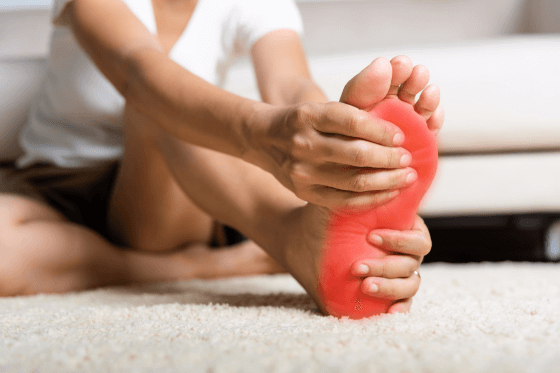Nerve discomfort can be one of the most frustrating and life-altering conditions to live with. Whether it’s the burning, tingling, or numbness that travels down your arms or legs—or a constant dull ache that just won’t go away—it can make even the simplest activities feel overwhelming.
The good news? You don’t have to rely on pills, injections, or surgery to get relief. Physical therapy has helped many of our patients at Houghton Physical Therapy find real, lasting relief from nerve pain.
In this blog, we’ll explore the common causes of nerve discomfort and how physical therapy offers effective, natural solutions.
Common Causes of Nerve Discomfort
Nerve discomfort can be triggered by a wide range of health conditions and lifestyle factors. Here are some of the most common causes:
1. Injuries (Acute Trauma or Repetitive Strain)
A fall, accident, or repetitive motion (like typing or lifting) can cause inflammation or compression of nerves. Over time, even small repetitive strains can build up and lead to nerve dysfunction.
2. Age-Related Changes Affecting Nerve Function
As we age, our spine and joints naturally degenerate. Discs can thin, and bone spurs may form, which may put pressure on nearby nerves—often resulting in sciatic-type discomfort, numbness, or tingling.
3. Autoimmune Conditions (Multiple Sclerosis or Lupus)
These conditions can trigger inflammation throughout the body, which may impact nerve pathways and create widespread nerve discomfort. It’s common for patients to feel both fatigued and frustrated.
4. Chronic Illnesses (Diabetes or Fibromyalgia)
Diabetic neuropathy is one of the most well-known forms of chronic nerve damage. High blood sugar levels over time damage nerves, particularly in the hands and feet. Fibromyalgia, while less understood, also causes widespread discomfort, often impacting the nervous system’s pain processing.
5. Cancer Treatments (Chemotherapy-Induced Nerve Damage)
Chemotherapy, while life-saving, can often damage nerves—especially in the hands and feet. This condition, known as chemotherapy-induced peripheral neuropathy (CIPN), can make daily movement feel unsafe or painful.
6. Nutritional Deficiencies (B12 Deficiency)
A lack of vitamin B12 can significantly affect nerve health. It may cause tingling, balance issues, and even cognitive difficulties. This is a more common issue than many people realize.
How Physical Therapy Helps Ease Nerve Discomfort Naturally
At Houghton Physical Therapy, we focus on natural, hands-on methods that support the body’s own healing mechanisms. Here’s how physical therapy can help ease nerve discomfort and restore mobility:
Targeted Exercises to Strengthen and Support Nerve Health
Strengthening the right muscle groups helps reduce pressure on irritated nerves. We guide you through a safe, individualized program designed to improve posture, enhance circulation, and support healing. Strength training isn’t just about lifting weights—it’s about retraining the nervous system to function optimally.
How Nerve Gliding Exercises Can Reduce Discomfort and Improve Mobility
Nerve glides are gentle movements that encourage the nerve to move more freely within its surrounding tissues. These exercises can reduce irritation, restore flexibility, and decrease the hypersensitivity that often accompanies nerve injuries. We often teach these early in a recovery plan because they’re low-impact and highly effective.
Joint Mobilization: Restoring Movement and Easing Nerve Discomfort
When a joint doesn’t move well—especially in the spine, shoulders, or hips—it can compress nearby nerves. Through gentle manual techniques, we help restore normal joint function and reduce the tension and inflammation pressing on nerves.
Soft Tissue Therapy for Nerve Relief
Muscle tightness, fascia restrictions, and trigger points can all aggravate nerves. Soft tissue techniques such as myofascial release and trigger point therapy reduce muscular tension and create space for nerves to glide more freely, reducing symptoms.
Stimpod: A Noninvasive Pain Management Solution
One of our most innovative tools, the Stimpod, uses radio-frequency pulsed stimulation to calm overactive nerves. Patients with neuropathy, sciatica, and chronic nerve discomfort often see immediate improvements in sensitivity and movement. It’s safe, noninvasive, and medication-free.
How Better Posture Can Reduce Nerve Discomfort and Improve Mobility
Poor posture can compress nerves—especially in the neck, shoulders, and lower back. Forward head posture, rounded shoulders, and tight hips are common culprits. Our team teaches proper alignment and simple daily posture corrections to ease pressure on nerves and reduce flare-ups.
Take the First Step Toward Lasting Nerve Discomfort Relief
If you’ve been living with tingling, numbness, or burning sensations and feel like you’ve tried everything—you’re not alone. Many of our patients come to us after months or even years of frustration, only to discover that physical therapy was the missing piece.
We offer free telephone consultations so you can speak directly with one of our experienced physical therapists, ask questions, and determine if our approach is the right fit for you.
No pills. No surgery. Just real, lasting results from experts who care.
Call us today at (508) 223-2300 or click here to schedule your free consultation.
Let’s help you get back to living, moving, and enjoying your life—without the constant burden of nerve discomfort.
More Free Resources:
Download our free report: Stimpod Form – Houghton Physical Therapy
Read our blog: Unlocking Your Full Potential: How PT Helps You Live an Active Life – Houghton Physical Therapy
Read our blog: Our Best for Your Best: How We Help You Live Your Best Life Through Physical Therapy
Tags: pain, PT, nerve pain, tingling, neuropathy, burning, discomfort, pt near me



